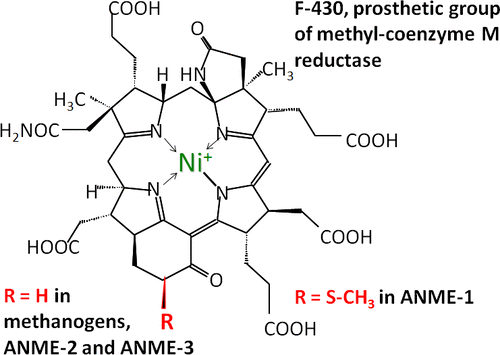当前位置:
X-MOL 学术
›
Biochemistry
›
论文详情
Our official English website, www.x-mol.net, welcomes your
feedback! (Note: you will need to create a separate account there.)
Methyl (Alkyl)-Coenzyme M Reductases: Nickel F-430-Containing Enzymes Involved in Anaerobic Methane Formation and in Anaerobic Oxidation of Methane or of Short Chain Alkanes.
Biochemistry ( IF 2.9 ) Pub Date : 2019-04-05 , DOI: 10.1021/acs.biochem.9b00164
Rudolf K Thauer 1
Biochemistry ( IF 2.9 ) Pub Date : 2019-04-05 , DOI: 10.1021/acs.biochem.9b00164
Rudolf K Thauer 1
Affiliation

|
Methyl-coenzyme M reductase (MCR) catalyzes the methane-forming step in methanogenic archaea. The active enzyme harbors the nickel(I) hydrocorphin coenzyme F-430 as a prosthetic group and catalyzes the reversible reduction of methyl-coenzyme M (CH3-S-CoM) with coenzyme B (HS-CoM) to methane and CoM-S-S-CoB. MCR is also involved in anaerobic methane oxidation in reverse of methanogenesis and most probably in the anaerobic oxidation of ethane, propane, and butane. The challenging question is how the unreactive CH3-S thioether bond in methyl-coenzyme M and the even more unreactive C-H bond in methane and the other hydrocarbons are anaerobically cleaved. A key to the answer is the negative redox potential (Eo') of the Ni(II)F-430/Ni(I)F-430 couple below -600 mV and the radical nature of Ni(I)F-430. However, the negative one-electron redox potential is also the Achilles heel of MCR; it makes the nickel enzyme one of the most O2-sensitive enzymes known to date. Even under physiological conditions, the Ni(I) in MCR is oxidized to the Ni(II) or Ni(III) states, e.g., when in the cells the redox potential (E') of the CoM-S-S-CoB/HS-CoM and HS-CoB couple (Eo' = -140 mV) gets too high. Methanogens therefore harbor an enzyme system for the reactivation of inactivated MCR in an ATP-dependent reduction reaction. Purification of active MCR in the Ni(I) oxidation state is very challenging and has been achieved in only a few laboratories. This perspective reviews the function, structure, and properties of MCR, what is known and not known about the catalytic mechanism, how the inactive enzyme is reactivated, and what remains to be discovered.
中文翻译:

甲基(烷基)辅酶M还原酶:含镍F-430的酶,涉及厌氧甲烷的形成以及甲烷或短链烷烃的厌氧氧化。
甲基辅酶M还原酶(MCR)催化产甲烷古菌中的甲烷形成步骤。活性酶带有镍(I)氢辅酶辅酶F-430作为辅基,并催化将辅酶B(HS-CoM)的甲基辅酶M(CH3-S-CoM)可逆还原为甲烷和CoM-SS- CoB。MCR还参与甲烷化生成的逆过程中的厌氧甲烷氧化,最有可能参与乙烷,丙烷和丁烷的厌氧氧化。充满挑战的问题是,如何在甲基辅酶M中无反应的CH3-S硫醚键以及在甲烷和其他烃类中无反应的CH键被厌氧裂解。答案的关键是在-600 mV以下的Ni(II)F-430 / Ni(I)F-430对的负氧化还原电势(Eo')和Ni(I)F-430的自由基性质。然而,负一电子氧化还原电位也是MCR的致命弱点。它使镍酶成为迄今为止已知的对O2最敏感的酶之一。即使在生理条件下,MCR中的Ni(I)也会被氧化为Ni(II)或Ni(III)状态,例如当细胞中CoM-SS-CoB / HS-的氧化还原电位(E')时CoM和HS-CoB对(Eo'= -140 mV)变得太高。因此,产甲烷菌具有用于在ATP依赖的还原反应中重新活化灭活的MCR的酶系统。Ni(I)氧化态的活性MCR的纯化非常具有挑战性,仅在少数几个实验室中就已实现。该观点回顾了MCR的功能,结构和性质,有关催化机理的已知和未知,无活性酶如何重新活化以及还有待发现的内容。
更新日期:2019-11-18
中文翻译:

甲基(烷基)辅酶M还原酶:含镍F-430的酶,涉及厌氧甲烷的形成以及甲烷或短链烷烃的厌氧氧化。
甲基辅酶M还原酶(MCR)催化产甲烷古菌中的甲烷形成步骤。活性酶带有镍(I)氢辅酶辅酶F-430作为辅基,并催化将辅酶B(HS-CoM)的甲基辅酶M(CH3-S-CoM)可逆还原为甲烷和CoM-SS- CoB。MCR还参与甲烷化生成的逆过程中的厌氧甲烷氧化,最有可能参与乙烷,丙烷和丁烷的厌氧氧化。充满挑战的问题是,如何在甲基辅酶M中无反应的CH3-S硫醚键以及在甲烷和其他烃类中无反应的CH键被厌氧裂解。答案的关键是在-600 mV以下的Ni(II)F-430 / Ni(I)F-430对的负氧化还原电势(Eo')和Ni(I)F-430的自由基性质。然而,负一电子氧化还原电位也是MCR的致命弱点。它使镍酶成为迄今为止已知的对O2最敏感的酶之一。即使在生理条件下,MCR中的Ni(I)也会被氧化为Ni(II)或Ni(III)状态,例如当细胞中CoM-SS-CoB / HS-的氧化还原电位(E')时CoM和HS-CoB对(Eo'= -140 mV)变得太高。因此,产甲烷菌具有用于在ATP依赖的还原反应中重新活化灭活的MCR的酶系统。Ni(I)氧化态的活性MCR的纯化非常具有挑战性,仅在少数几个实验室中就已实现。该观点回顾了MCR的功能,结构和性质,有关催化机理的已知和未知,无活性酶如何重新活化以及还有待发现的内容。































 京公网安备 11010802027423号
京公网安备 11010802027423号